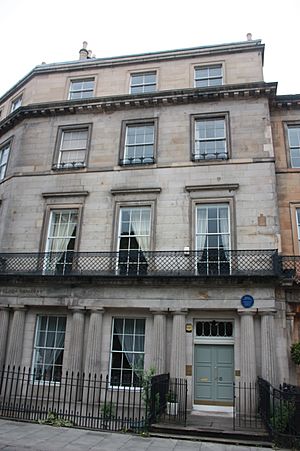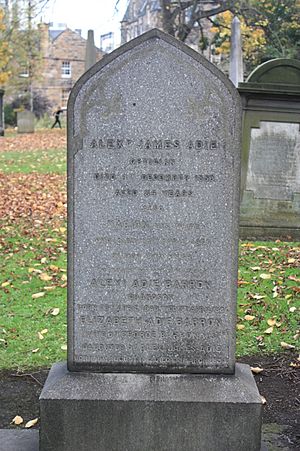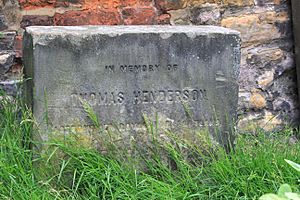Thomas Henderson (astronomer) facts for kids
Quick facts for kids
Thomas Henderson
|
|
|---|---|

Thomas Henderson, c.1820s
Scottish Astronomer Royal |
|
| Born | 28 December 1798 Dundee, Scotland
|
| Died | 23 November 1844 (aged 45) |
| Nationality | Scottish |
| Known for | distance to Alpha Centauri |
| Scientific career | |
| Fields | astronomy |
| Institutions | City Observatory, Edinburgh |
Thomas Henderson (born December 28, 1798 – died November 23, 1844) was a Scottish astronomer and mathematician. He is famous for being the first person to measure the distance to a star called Alpha Centauri. This star is part of the closest star system to Earth. He was also the first to figure out the "parallax" of a fixed star. Parallax is how a star seems to shift position when viewed from different points in Earth's orbit. Henderson was also the first official Astronomer Royal for Scotland.
Contents
Early Life and Discovering Astronomy
Thomas Henderson was born in Dundee, Scotland. He went to the High School of Dundee. After school, he trained to become a lawyer. He worked for different important people, learning the law.
But his real passions were astronomy and mathematics. He loved studying the stars and numbers. He even found a new way to use lunar occultation to measure longitude. Lunar occultation is when the Moon passes in front of a star. Longitude helps you find your exact location on Earth.
His clever ideas caught the eye of Thomas Young. Young was in charge of the Royal Navy's "Nautical Almanac." This book helped sailors navigate. Young helped Henderson get involved in the world of astronomy. When Young passed away, he even suggested Henderson take his place.
Career Highlights
Exploring the Stars from Africa
Henderson didn't get Young's job, but his recommendation was enough. He got a position at the Royal Observatory, Cape of Good Hope in South Africa. He worked there from April 1832 to May 1833. During this time, he made many important observations of stars.
A fellow astronomer, Manuel John Johnson, told him that the bright southern star Alpha Centauri moved a lot in the sky. This movement is called "proper motion." Henderson thought this meant Alpha Centauri might be very close to Earth.
In the 1830s, astronomers were in a "space race." They all wanted to be the first to measure the distance to a star. This is easier to do if the star is closer. Henderson was in a great position to win this race.
He returned to the UK because of his health. There, he started to analyze his measurements. He found that Alpha Centauri was a little less than one parsec away. This is about 3.25 light years. A light-year is the distance light travels in one year. His measurement was quite accurate!
However, Henderson didn't publish his findings right away. Other astronomers had tried and failed to measure star parallax before. He was worried his results might be wrong. Because of this, he was beaten by Friedrich Wilhelm Bessel. Bessel published his measurement for another star, 61 Cygni, in 1838. Henderson finally published his results in 1839. But he was second because he waited.
Later, another astronomer named Thomas Maclear confirmed Henderson's measurements. Alpha Centauri was the closest known star until Proxima Centauri was discovered in 1915.
Becoming Scotland's Astronomer Royal
Because of his excellent work in Africa, Thomas Henderson was chosen for a new important job. In 1834, he became the first Astronomer Royal for Scotland. This meant he was the chief astronomer for the country. The Prime Minister, Lord Melbourne, suggested he also get the astronomy professor job at the University of Edinburgh.
From 1834 until he passed away, he worked at the City Observatory in Edinburgh. It was then called the Calton Hill Observatory. In 1840, he became a Fellow of the Royal Society. This is a very respected group of scientists.
Henderson was also a member of other important groups. These included the Royal Astronomical Society (in 1832) and the Royal Society of Edinburgh (in 1834).
Personal Life and Legacy
Thomas Henderson married Janet Mary Adie in 1836. She was the daughter of Alexander Adie. They had one daughter, also named Janet Mary Jane Henderson.
Thomas Henderson died at his home in Edinburgh on November 23, 1844. He is buried in Greyfriars Kirkyard.
Recognition and Memorials
You can find a blue plaque on his old house at 1 Hillside Crescent in Edinburgh. This plaque remembers him and his work.
There is also a larger memorial for him. It is built into the outside wall of the City Observatory where he worked.
An Asteroid in space, 3077 Henderson, is named after him. This is a great honor for an astronomer!
|





